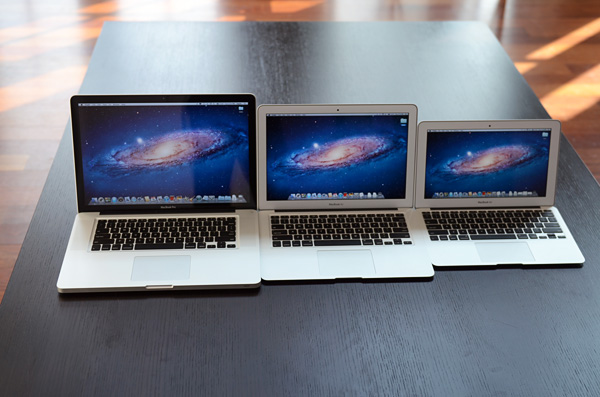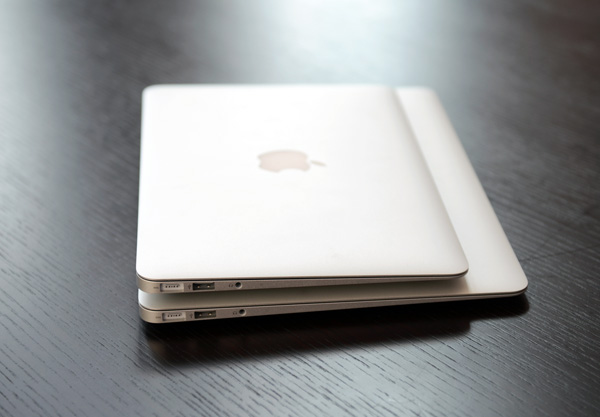The 2011 MacBook Air (11 & 13-inch): Thoroughly Reviewed
by Anand Lal Shimpi on July 28, 2011 3:25 AM EST- Posted in
- Apple
- Mac
- Intel
- Sandy Bridge
- MacBook Air
- Laptops
Final Words
Whereas last year's MacBook Air was a good machine for light work, the 2011 models are true replacements for mainstream portable Macs. There's still no dethroning the MacBook Pro (although the 13-inch model clearly needs a higher resolution display option), but for the rest of the world there are now some excellent ultra portable options that don't force you to really compromise on performance.
Both the 11 and 13-inch MacBook Air are fast enough to replace your 3 year old MacBook Pro and still deliver better performance. You can even move from a 2010 MacBook Pro to an upgraded MacBook Air and not notice any drop in performance. All of this is thanks to Intel's Sandy Bridge CPU.

From left to right: 15-inch MacBook Pro, 13-inch MacBook Air, 11-inch MacBook Air
It's the GPU performance that I'm less excited about. While last year's GeForce 320M isn't significantly faster than the HD 3000 in the new MacBook Air, it's still faster in our tests. There's not much Apple could've done about this. I don't believe a discrete GPU in an Air makes sense, but this should be a clear message to Intel. Sandy Bridge's GPU is the bare minimum, we need to really see a real ramp in performance from here on out. Ivy Bridge will give us a bit of that but not another doubling in GPU performance. Perhaps we'll see something significant from Haswell in 2013. For now, if you like gaming on the go you'll have to get a MacBook Pro.
When it comes to battery life the new MacBook Air doesn't break any records, but it doesn't disappoint either (at least under OS X). With the exception of the our light web browsing test, the new MacBook Air behaves pretty similarly to last year's model on battery power. The new 13 doesn't do anywhere near as well in mostly idle scenarios but under moderate to heavy load the new MBAs last at least as long as their predecessors.
The only move I would be careful about is a downgrade from a 13-inch 2011 MacBook Pro. The new 13-inch MBP is still considerably faster than the MacBook Air, while the more portable form factor is tempting you're better off waiting to see what Apple does with the next update to the MacBook Pro.
If you were a fan of the original MacBook Air, the 2011 models are just as significant of an introduction as the very first one in 2008. They may not look any different from the outside, but the new 11 and 13-inch MacBook Air are a significant step forward. These systems are no longer niche ultraportables, they've instead brought the ultraportable niche into the mainstream.
If you're stuck deciding between the two I think it breaks down like this. If you've got a beefy system at home and just need something portable for travel, the 11-inch Air is perfect. It's now fast enough to get real work done on the road and portable enough to feel like a tablet with an integrated keyboard. If you're replacing a primary notebook however, the 13 is the safer bet. It is sized like a normal notebook, you get longer battery life and a bigger screen to look at. If you're a fan of extremes, the 11 is for you. If you like balanced compromises, go with the 13.
What happens from here on out is what's really interesting. Intel has already committed to moving the TDP of its mainstream parts from 35W - 45W down to 10 - 20W. Since the Air is the new mainstream Mac notebook, Apple has already made that move. The performance in this 10 - 20W segment is going to get much better over the next two years, particularly once Haswell arrives.
The Thunderbolt Display is the first sign of what's to come. Moving IO controllers and expansion into the display, and potentially even moving discrete GPUs out of the notebook are all in store for us. Apple is really ahead of the curve here, but it's easy to imagine a future where laptops become a lot more like the new Air and shift to a couple high bandwidth ports instead of numerous lower bandwidth connections.
There's a lot to like with the new MacBook Airs; the last update was good, but performance was still often lacking. The MBA 11 in particular is now much more useful, and the 13 rightfully spells the end of the line for the old MacBook. While pricing is higher than typical 11" to 13" Windows laptops, you really can't find a competing Windows laptop with all the features the MBA offers without paying a similar price premium. You get a nice chassis with excellent build quality, decent displays that trump every budget laptop we've looked at, and reasonable battery life. If you like thin and light ultraportables, the MacBook Air continues to be one of the best options around.











103 Comments
View All Comments
OCedHrt - Tuesday, August 2, 2011 - link
35W is maximum draw I think. On average you don't use that much, and on idle you save even less. My Z, as an entire system, draws 22W on average during browsing.darwinosx - Saturday, July 30, 2011 - link
If you had actually read the review or knew anything about the Sony Z you would know that this is a different ultra low voltage i5 processor that was just released. You would also know that Sony's are higher priced, poorly made, little service and support, and run Windows.OCedHrt - Tuesday, August 2, 2011 - link
I would know that my Z runs fast, plays my games, carries around just as light as an Air, is built to last, never needed support, and cost me less. And people still have their 3 gen old Z's running core duos going strong.The Z does not want a ULV processor. ULV is only good if you want to increase your battery life at the cost of performance. The Sony Z does not lose to Air in battery life at all. Just because something just came out doesn't necessarily make it ideal. Would there be a market for the new Z with ULV? Maybe, and it will then kill the Air in battery life and probably cost even less.
KPOM - Thursday, July 28, 2011 - link
As usual, a nice and thorough review. Thanks for the comparison to the i7, as well.Apple did a nice job with this one. They have created a mainstream "ultra book" months before the others come out with their blessed-by-Intel versions. It isn't as powerful as the Vaio X, but is more reasonably priced. It beats the relatively new Samsung Series 9 (which still relies on an i3 and less powerful graphics) while maintaining similar pricing. The i7 available in the 128GB 11" is a good deal at $1349. I opted for the 256GB 11" and got the Samsung (though the Toshiba would have been fine - I had one in my 2010 MacBook Air).
OCedHrt - Tuesday, August 2, 2011 - link
I hope you mean the Vaio Z. The X was amazing but it was a paper weight.iwod - Thursday, July 28, 2011 - link
The next gen of tech, Haswell, PCI-E 4.0, Thunderbolt 2.0, Faster SSD will be perfect fit for Macbook Air.lokiju - Thursday, July 28, 2011 - link
I wonder if Sony's Air challengers external GPU would work with this if you could get the physical ports adapted to fit...A external GPU would probably be more than it's worth for me but still a cool concept.
mschira - Thursday, July 28, 2011 - link
That last sentence made me think. Why not integrate the external graphic card into the external display?That would be neat.
M.
wicko - Thursday, July 28, 2011 - link
I think I would still prefer an external GPU kit or something. This way you still have choice in GPU and in monitor, including existing ones.tipoo - Thursday, July 28, 2011 - link
I'd prefer a separate box for the GPU so you don't have to toss the display when its outdated. With thunderbolt you could potentially connect the Air to the display, then daisychain the display to the GPU.